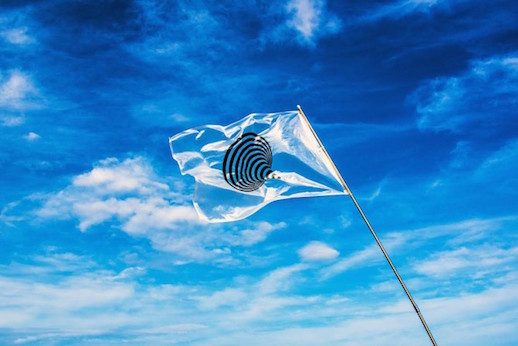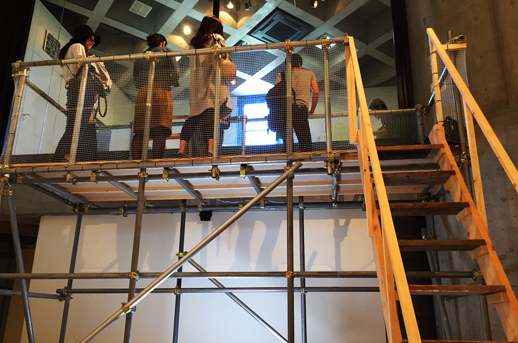Remember: Don’t Follow the Wind of Forgetfulness!

Four years have passed and the memory of the nuclear disaster, triggered by the most powerful earthquake and tsunami in modern Japanese history, is apparently fading. This lapse in recall is a result of an engineered social amnesia, aggressively pushed by the powers that be with the aim of erasing the memory of the crisis from our collective thought. The move to restart nuclear plants nationwide and the enactment of the State Secrets Law denying the public their right to know are among the collection of apparent proofs exposing this contrived forgetting.
In the face of these social currents, the Tokyo-based artist collective Chim↑Pom, together with a team of proactive curators made up of Jason Waite, Kenji Kubota, and the artist duo Eva and Franco Mattes, have come together to enliven the discourse of the Fukushima nuclear disaster and return it to public consciousness. They frame the hidden secret of this ongoing crisis in an artistic project.
This group of radicals, with the help of more than twelve artists including Ai Weiwei, Taryn Simon, Kota Takeuchi, Grand Giugnol Mirai, Nobuaki Takekawa, Trevor Paglen, Ahmet Ogur, Nicklaus Hirsch, and Jorge Otero-Pailos, refresh our memory of the disaster by inviting the public to look into a post-apocalyptic present. Here a compelling means of resisting forgetfulness and exercising the mind confront us, as we are continually asked to imagine what lies ahead of this crisis increasingly shrouded in secrecy.
The twist of the Fukushima exhibition is that it is currently inaccessible, having been installed in the highly contaminated nuclear exclusion zone, which may only be reached once restrictions on the district are lifted. The “displays” are in effect invisible, just as the radiation surrounding the site is. Given the obvious impossibility of seeing the actual works, the artists have established an off-site “satellite” space for their engagements at the Watari Museum of Contemporary Art in the form of “Don’t Follow the Wind Non-Visitor Center.” Yet, as the title suggests, even here the viewer is hindered in directly observing representations of the distant exhibits. Rather, the shapes the works take are hinted at through legal documents, surveillance videos, installation pieces, and audio guides that demand the audience imagine, rather than physically encounter, the pieces within the restricted zone.
It is apt that this “exhibit” may only be accessed through the enclosed space of the elevator, a permanent feature of the museum’s architecture. In this lift, different possibilities are suspended, ready to explode once the door opens to a chosen destination – assuming there are no restrictions, that is. The approach somehow illustrates Chim↑Pom’s question about the future and the possibility of return, both of which appear suspended in their actuality of a single moment.
From these ideas of suspended actuality*, restrictions, and exclusion, the artists have generated works to stimulate discourse about the ongoing nuclear crisis in Japan and spark further questions about humanity’s relationship to the future of the planet.

The “invisible” is relayed to the “non-visitor” via the aid of an audio guide which describes the interventions of the team of artists within the forbidden district. Ai Weiwei, for instance, while under house arrest by the Chinese authorities, had photographs of daily life in Beijing and his own family snapshots added to local residents’ homes in the exclusion zone. These citizens, like the artist, are denied the liberty of movement. Such imposed restrictions discussed in Ai Weiwei’s work outline the suspended future depicted throughout the exhibition. But just what kind of future is it? “We don’t know yet, unless the restrictions are lifted!” Chim↑Pom exclaims.
In contrast, Kota Takeuchi attempts to identify this unknown future in photographic self-portraits in which he wears garments left behind by residents in the exclusion zone, simultaneously portraying himself as an archaeologist from another future investigating the legacy of a time gone wildly wrong. In doing so, he reveals to us that unknowable point beyond now.
In light of this suspended actuality combined with constraints on knowledge and recollection, only the imaginative forces can combat the slow demise of the synapses frequently suffered by Alzheimer’s disease patients. This is precisely what the exhibition tries to tell us, warning the public that if we cease to remember, we cease to be.
“Don’t Follow the Wind” helps us reverse the slide towards a slow disintegration of the social brain. By recalling the nuclear crisis and imagining possible alternative futures that might expand from it, perhaps we may find some hope for humanity and our planet.
“Don’t Follow the Wind Non-Visitor Center” runs until 3rd November at Watari Museum of Contemporary Art.
* “Suspended Actuality” is here coined as an interpretation of the quantum experiment known as “Schrodinger’s Cat”, where a system only stops being a superposition of states once an observation takes place. However, since the observation of Fukushima is restricted the state remains a superposition or an unknown.
Jong Pairez
Jong Pairez



